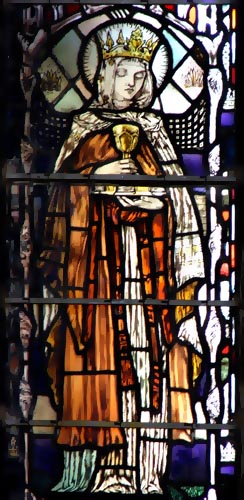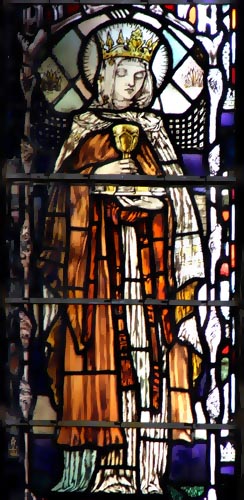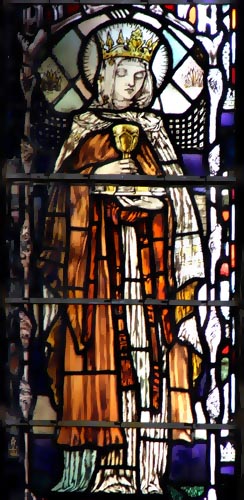At the age of only three, it is said the young princess was offered the choice of a small chalice and paten or gold and jewellery. The little girl eagerly took up the former and thus convinced her father of her ultimate vocation. She was soon placed under the educational charge of a Royal cousin, Abbess Ethelthritha of the Nunnaminster in Winchester, whose community received endowments and gifts from the grateful monarch. As King Edward had foreseen, his daughter became revered for her holiness even within her own lifetime. She was loved by all her contemporaries for her gentleness and humility. She even washed the socks of her fellows by night. It is not clear whether she eventually became Abbess of the Nunnaminster herself, but she was certainly one of its best known nuns. Edburga died at the Abbey, probably around AD 960 (though possibly as early as AD 951). She was only about thirty at the time. She was buried within the Abbey church and quickly accepted as a saint, though some of her relics were later translated to Pershore Abbey in Worcestershire. Edburga's feast is celebrated in 15th June.
∼Died 960. Saint Edburga was a granddaughter of King Alfred and the daughter of Edward the Elder. It is reported that, while she was still a young child, her royal father offered her precious jewels in one hand and a penitential habit in the other. Edburga chose the latter joyfully. At that her parents placed her in Saint Mary's Convent, which was founded by Alfred's widow, Alswide, at Winchester, finished by her own father, and placed under the direction of Saint Etheldreda. Having finished her education, Edburga became a nun and later the abbess of the foundation. After Edburga died of a fever, Bishop Saint Ethelwold placed her remains in a rich shrine, which Abbess Saint Elfleda covered with gold and silver. When the Earl Egilwald of Dorsetshire sought relics for his newly rebuilt foundation of Pershore in Worcestershire after its pillage by the Danes, the abbess give him part of Edburga's skull, some of her ribs, and other bones, which were enclosed in a rich case. She was especially venerated at Pershore in Worcestershire, where these relics were enshrined and many miracles have taken place, and at Saint Mary's in Winchester
At the age of only three, it is said the young princess was offered the choice of a small chalice and paten or gold and jewellery. The little girl eagerly took up the former and thus convinced her father of her ultimate vocation. She was soon placed under the educational charge of a Royal cousin, Abbess Ethelthritha of the Nunnaminster in Winchester, whose community received endowments and gifts from the grateful monarch. As King Edward had foreseen, his daughter became revered for her holiness even within her own lifetime. She was loved by all her contemporaries for her gentleness and humility. She even washed the socks of her fellows by night. It is not clear whether she eventually became Abbess of the Nunnaminster herself, but she was certainly one of its best known nuns. Edburga died at the Abbey, probably around AD 960 (though possibly as early as AD 951). She was only about thirty at the time. She was buried within the Abbey church and quickly accepted as a saint, though some of her relics were later translated to Pershore Abbey in Worcestershire. Edburga's feast is celebrated in 15th June.
∼Died 960. Saint Edburga was a granddaughter of King Alfred and the daughter of Edward the Elder. It is reported that, while she was still a young child, her royal father offered her precious jewels in one hand and a penitential habit in the other. Edburga chose the latter joyfully. At that her parents placed her in Saint Mary's Convent, which was founded by Alfred's widow, Alswide, at Winchester, finished by her own father, and placed under the direction of Saint Etheldreda. Having finished her education, Edburga became a nun and later the abbess of the foundation. After Edburga died of a fever, Bishop Saint Ethelwold placed her remains in a rich shrine, which Abbess Saint Elfleda covered with gold and silver. When the Earl Egilwald of Dorsetshire sought relics for his newly rebuilt foundation of Pershore in Worcestershire after its pillage by the Danes, the abbess give him part of Edburga's skull, some of her ribs, and other bones, which were enclosed in a rich case. She was especially venerated at Pershore in Worcestershire, where these relics were enshrined and many miracles have taken place, and at Saint Mary's in Winchester
Family Members
Advertisement
Advertisement











